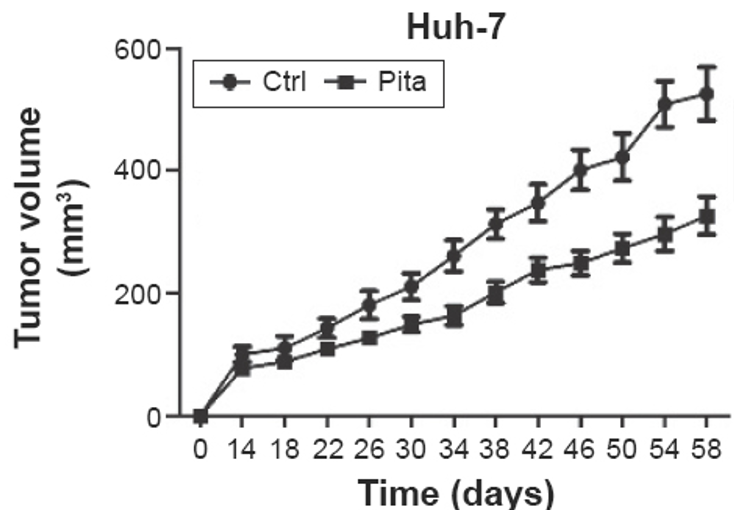General Information
The HuH-7 cell line was established in 1982 from a well differentiated hepatocyte derived cellular carcinoma cell line that was originally taken from a liver tumor in a 57-year-old Japanese male. The line was established by Nakabayshi, H. and Sato, J. Huh-7 is highly susceptible to the hepatitis C virus (HCV), and it is often used as a model to investigate hepatoma and HCV. This cell line can be used for an HCV replicon system, which allows for an in vitro production of infectious HCV particles and development of drugs that combat HCV.
Huh-7 Characteristics
Huh-7 is an immortal cell line composed of epithelial-like, tumorigenic cells. The majority of Huh-7 cells show a chromosome number between 55 and 63 (mode 60) and are highly heterogeneous. These cells are adherent to the surface of flasks or plates and typically grow as 2D monolayers. Although containing many mutations and INDELS, it is worthy to note the Huh7 cells have a point mutation in the p53 gene.
Huh-7 Xenograft Model

The Huh-7 cell line (origin: human liver) is used to create the Cell Line Derived Xenograft (CDX) HuH-7 mouse model. The HuH-7 CDX model of human hepatocellular carcinoma is a mouse model that enables pre-clinical tumor growth inhibition studies targeting kinase inhibitors (e.g. BZG-4000), FGFR4, anti-EGFRvIII antibodies and other novel anti-tumor growth therapeutics (e.g. sorafenib, silibinin).
Briefly, exponentially growing Huh-7 cells are injected into the flank of an immunodeficient mouse. The tumors are allowed to grow until reaching a starting size of 150 mm3. Upon reaching the starting tumor size, mice are injected with test article according to the study design. Tumor growth is continually monitored with caliper measurements in order to decipher tumor growth inhibition.
Figure: Pitavastatin suppressed liver cancer cells in vitro and in vivo. You HY, Zhang WJ, Xie XM, Zheng ZH, Zhu HL, Jiang FZ. OncoTargets and Therapy. 29 August 2016, Volume 2016:9 Pages 5383—5388.
3D Culture Model for HCV Transfection Study
To use as a hepatocyte culture model, Huh-7 was cultured in 3-D Rotating Wall Vessel (RWV) bioreactors engineered by NASA. This is a horizontally rotating cylindrical culture vessel that is meant to grow cells in 3D aggregates, without the shear and turbulence associated with conventional, stirred bioreactors. Cells cultured this way are grown much like the cells of a fetus in a mother’s uterus. The cells experience an environment with aspects of microgravity and “suspended animation”, where the cells are in constant free-fall. The fluid dynamics of the RWV cell culture allows cells to develop more naturally, in a 3D space, much like they would grow in vivo. This is in contrast to 2D plastic substrates in which most cells are grown in culture (plates). Thus, RWV grown cells are more similar, in structure and function, to their in vivo counterparts, resulting in a more physiologically relevant system for the study of viruses.
The difference between RWV and conventional cell culture is remarkable, and completely altered gene expression and differentiation patterns are often observed in RWV cultured cells. RWV promotes differentiation of the HCV receptive Huh-7 cells. The RWV grown Huh-7 cells are distinct from original Huh-7 cells both morphologically and transcriptionally. In the RWV, these cells form bulky aggregates that are more polarized than the original cells. RWV cells also exhibit greater regulation of metabolic and hepatocyte-specific transcripts, as well as increased expression of proteins necessary for the formation of tight junctions and cell adhesion.
Links
siRNA Delivery – In Vivo Transfection Kits
CRO Pre-clinical Research Services: Xenograft animal models
GLP-compliant Cell Banking services
Generation of Stably Expressing Cell Lines in 28 Days
Stable RNAi Cell Line Generation: Stable Gene Knockdown
In Vivo siRNA Delivery: Tissue-targeted siRNA
Encapsulation of Protein, RNA, mRNA, and DNA Molecules into Liposomes
HuH-7 Cells | HuH-7 Cell Culture | HuH-7 Transfection | Get HuH-7 Transfection Reagent